Welcome to Forgotten Lore, where you’ll find the greatest comic-book stories that you’ve never known.
Our first subject of obscurity is a 12-page epic entitled “The Prophet.” This story is one of seven features in Bizarre Adventures #32, published by Marvel Comics back in May of 1982. Denny O’Neil edited this group of tales crafted around the theme of gods (both ancient and modern). The cover notes that this issue is about “Thor and other gods…” and the word “GODS” is printed in big letters on the title page. Underneath that word is a quote: “All men have need of the gods.” – Homer. Right off, we can tell that heady material lies ahead, but in the wrappings of Marvel merriment.
Naturally, the lead story is about Marvel’s Thor, God of Thunder. Check out this nifty cover by Joe Jusko:
This series is one of several black-and-white anthologies Marvel was publishing in the ‘70s and early ‘80s. Marvel put out a bunch of these titles during this time in an attempt to get in on the comics-magazine market in which Warren Publishing (producers of Creepy, Eerie, and Vampirella) had achieved success.
Since magazines were not submitted to the Comics Code Authority, they were permitted to exhibit much edgier content than would be allowed in the color comics line. This created a publishing environment in which familiar Marvel characters would be featured in stories more adult or intellectual than usual. Before comic-book publishing imprints like Epic, Vertigo, and Ultimate made these kinds of stories common, you had to go to the magazine format for “mature” comics content.
Thus, “Gods” was a viable subject for exploration through sequential art in the pages of Bizarre Adventures magazine. Kicking off issue #32 is a 14-page Thor story called “Sea of Destiny,” in which the Asgardian prince is drawn into battle with a giant sea-horse. This is actually much cooler than it sounds. The following image of Thor throwing Mjolnir at this horse monster’s massive head is, by itself, worth the $1.50 price tag for the issue.
This is a cool Thor battle from Alan Zelenetz (script) and John Bolton (art), but the real gem of this book is actually yet to come. A few features further into the issue is a story written by Mark Gruenwald and drawn by Val Mayerik entitled “The Prophet.” This tale also stars a Marvel super-hero, but he goes unnamed throughout the entire narrative. Only referred to as “prophet,” our protagonist is an old man living by himself in the mountains. The bizarre adventure begins when a similarly unnamed “seeker” hikes into the Canadian wilderness in order to learn enlightenment from this particular old man.
The seeker is successful in finding the object of his search. The prophet is floating in the air, fast asleep, at the top of the mountain!
The seeker builds a fire and waits for the prophet to awaken. The old man appears to have put himself as distant from humanity as he was able. Yet upon awakening, he’s not hostile to the seeker that has disturbed his peace. When the seeker’s torch is mysteriously extinguished for no apparent reason, the old man apologizes.
We can see here that the prophet holds a staff and has grown a long beard. The imagery is like that of Moses from the Old Testament of the Bible. His elevated status in the seeker’s mind, along with the Biblical parallels and the sobriquet of prophecy, creates a religious mystique about this character that remains prevalent throughout the story.
Note that the character of the prophet himself does not make claim to any religious power or significance. He has only desired to communicate that he has foreseen celestial salvation for the human race. The prophet states that he first attempted to spread his message to humanity 200 years in the past. A flashback scene shows that “200 years in the past” is our modern society, a “tumultuous era” in which the prophet was able to gather a flock of disciples. These were people eager for spiritual stability in an uncertain age. So we discover the story of the seeker and the prophet that we’ve been reading takes place in the future! The old man goes on to tell the seeker that when all of mankind had indeed been granted wondrous powers in accordance with his prophecy of celestial destiny, his followers began to gradually leave him. Super powers were seen by the world as an end unto themselves, not a signal for a greater transcendence of mankind yet to come.
We must digress at this point, for we have also discovered that the prophet is in fact the Marvel hero known as Aquarian. It’s subtle, but there is no mistaking Aquarian’s costume in the flashback scene. Also, since Mark Gruenwald wrote this tale, and since he’s essentially the creator of Aquarian, I think it’s a safe bet that we can refer to this character as Aquarian from this point on. “Who is Aquarian?” you may be asking. The answer goes back to Steve Gerber’s Man-Thing run.
In Fear #17, writer Steve Gerber and penciler Val Mayerik (note that the artist of “The Prophet” also drew Aquarian’s first appearance) explore the idea of a Superman analog that emerged from the rocketship as a fully grown man rather than a child.
Man-Thing encounters a strange metal pod in the midst of his Florida swampland stomping grounds. He inadvertently frees the parallel Kal-El from his ship, and the young man experiences outside reality for the first time. So the last survivor of a doomed planet has super powers on Earth, but possesses neither a moral code nor identity. He has no knowledge or experience of any kind save that of his existence in the rocketship womb that had sustained him. Though he wishes the Man-Thing no harm, they come into conflict over misjudged super-strength and mutual misunderstanding.
Man-Thing has unwittingly released a super-powered man, eventually identified as Wundarr. The man with an infant’s mind fights a man without a mind. Property damage and confusion are the result. Just another in a series of surreal tales of the Man-Thing under Gerber’s typewriter. Wundarr would go on to become sort of a sidekick to Ben Grimm during Gerber’s run on Marvel Two-In-One, Marvel’s 1970s Thing team-up series. Eventually the Wundarr character came under the purview of Ralph Macchio and Mark Gruenwald, writers of Marvel Two-In-One later on in the series. During the “ Project: Pegasus Saga,” Wundarr made a powers, costume, and codename change. Starting from Marvel Two-In-One #58, Wundarr became known as Aquarian.
In MTIO #58, the titanic team-up of The Thing, Giant-Man, Quasar, Thundra, and Aquarian. In hindsight, they should’ve been an ongoing team with their own series.
At the climax of the Pegasus saga, Wundarr awakens from the Cosmic Cube-induced coma he’s been in for 15 issues. He finds that his mind has adjusted during his long sleep and he now has the ability to verbalize normally. But the big deal is Aquarian’s main superpower: he’s surrounded by a null zone that dampens any and all energy. He can alter the size and strength of the field, but cannot dissipate it completely. Aquarian always exists within a null zone wherever he goes. The nullifying field is a handy super power though, since it can neutralize energy attacks, including kinetic energy. Captain America can’t take down Aquarian with his shield or even the force of his own body.
But why take the name “Aquarian”? The zodiac sign of Aquarius is even on the belt of some versions of Aquarian’s costume. What is the significance of these things?
- Aquarius Zodiac Symbol
- January 20 – February 18
- Water-Bearer
It is never explained in detail, but the general idea behind this codename seems to be that Aquarian is personifying the social conscience supposedly harbored by people born under the sign of Aquarius. The word “aqua” is the original Latin word for water and people born under this zodiac sign are symbolized by the Water-Bearer. And as a Water Bearer administers the liquid that makes life possible, so Aquarians water the world with their thoughts and new ideas, usually towards humanitarian and philanthropic ends. The so-called “Age of Aquarius” in pop culture refers to hippie and New Age movements in the ‘60s and ‘70s that appointed themselves as harbingers of a great change in social consciousness. It’s been espoused by New Age philosophers that Aquarians are needed to help humanity evolve during the new millennium. Looks like Wundarr wanted this path for his life. What if Superman were a hippie?
So we’ve witnessed the second (third?) birth of the Aquarian in the pages of Marvel Two-In-One. We can garner from his status quo change what this character is about. What was next for Aquarian? He’s made sporadic appearances in the Marvel Universe, most recently during Secret Invasion, but I submit that Gruenwald and Mayerik went right to the ultimate destiny of Aquarian in the story of “The Prophet.” Let’s now return to that tale, and learn what the seeker says in response to the prophet’s life story. The old man had been saying that he’d distanced himself from human beings four decades ago and had purged his own desire to share the wonders of his celestial vision. The prophet reasons that when salvation comes, no one will need him to know of its arrival. This is a key point. The prophet had only wanted to guide humanity up until the point of salvation, but he was rejected. Yet the seeker presses the old man, exclaiming that he embraces the message of the prophet.
So the seeker tells a tale of his own, in which he too is rejected by humanity. In the 22nd century, everyone has powers…except him. The seeker learns about the prophet at school, and wonders at how the old man had long ago predicted the era of transformation that had left him behind. He seeks the prophet because no one else could possibly tell him why he had been forsaken by fate (or God?). So this forsaken pair has at last found one another. The old man philosophizes to himself during his meditations about how he and the young seeker are alike in their mutual ostracism by society. It’s at this moment that the ultimate aspect of Aquarian’s prophecy begins to manifest on Earth.
Aquarian senses that a planet-size starship is coming to Earth. He tells the seeker that they must depart in order to meet this starship and witness the return of the twelve. Off they go on an appointment with cosmic destiny, right off the edge of the mountain.
But this ship isn’t just coming to Earth, it’s returning. Mention is made of a group of chosen ones, these mysterious twelve. But who are the twelve? Some of what the prophet now tells the seeker seem to be facts, not mere prophecy. It is unclear what information he knows for certain, what information is an aspect of his vision, and what the distinction between those two concepts really is. Although it should be noted that everything Aquarian prophetizes does indeed come to pass in the context of the narrative. Aquarian says that two centuries past, a host of celestial beings from the center of the universe came to Earth to judge mankind. An offering was made to the space gods: twelve of Earth’s finest sons and daughters, each of whom embodied one of mankind’s great arts and sciences. The Celestials judged mankind to be good and took the twelve chosen ones into their ship to be tutored in the secrets of the cosmos. Upon completion of their discipleship, the twelve are destined to return to Earth to share with all mankind the wisdom and power they have gained. They are to teach mankind how to attain their potential for godhood and so assist humanity’s cosmic ascension.
Aquarian goes on to say that the transformation of the human race that made everyone into super-beings was to prepare the species for this moment of the return of the twelve, harbingers of humanity’s transcendence. Aquarian had been saying these things all along for centuries, to no avail. But humanity apparently didn’t need the information anyway. The rapture is at hand, and comes of no man’s will or understanding. The starship beams down the chosen twelve to the surface of the Earth. A poet, a farmer, a soldier, an artist, a mystic, a hunter, a physician, a navigator, a musician, a scientist, a builder, and a philosopher…
So the word “celestial” has been used frequently in the words of the prophet thus far, but is that word meant merely in the cosmic sense? Actually, it means much more than just the cosmos. We’re talking about Jack Kirby’s Celestials.
In Thor #300, the Celestials were making good on their promise to judge Earth. This was the fourth Celestial host (they’d visited Earth three times previously), the follow-up to Kirby’s Eternals series. Since Thor #283, the book had been building an arc that would incorporate the Celestials, Eternals, and Deviants fully into the Marvel Universe, where they have resided ever since. Though this story started with Roy Thomas as writer, by issue #300 the Two-In-One team of Macchio and Gruenwald had taken over scripting duties on Thor. Before the Celestials could render judgment, Odin confronts them while possessing the awesome power of all the Asgardians and the Destroyer…and the Destroyer dies!
So then Mother Earth, aka Gaea, makes her move against the Celestials. It’s a non-violent offering, a sacrifice. Gaea offers twelve of her children in exchange for the continued existence of humanity.
These twelve noble humans, aka the Young Gods, are apparently accepted by the Celestials and Earth is judged worthy to continue. The fourth host departs the Earth peacefully, taking the Young Gods with them.
Three of these twelve Young Gods go back to Thor #203, a Gerry Conway/John Buscema story in which Odin transforms a farmer, a soldier, and an artist into gods in order to thwart the machinations of Ego-Prime.
There’s a list of the entire twelve on Wikipedia:
- Bright Sword (Carter Dyam) was a 24-year old Israeli soldier who was approached by the Asgardian god Heimdall. First appeared in Thor #203 (Sep 1972).
- Caduceus (Mark Cadmon) the physician was approached in 1919 at the age of 30 to become one of the Young Gods. First appeared in Thor #300 (Oct 1980).
- Calculus (Jahaharel Patel) was a scientist, born in 1928, contacted by the gods of the Hindu pantheon at the age of 20. First appeared in Thor #300 (Oct 1980).
- Daydreamer (Catherine Moranis) was a 25-year-old farm woman in 19th-century Ottawa, Canada. First appeared in Thor #300 (Oct 1980).
- Genii (Jason Kimball) was a 26-year-old fashion designer when he was approached by the Asgardian god Heimdall in modern times. First appeared in Thor vol. 1, #202 (Aug 1972).
- Harvest (Chi Lo). First appeared in Thor #203 (Sep 1972).
- Highnote (Raoul Hernandez) was a saloon dancer and musician living in Colombia in the 19th century. First appeared in Thor #300 (Oct 1980).
- Mindsinger (Gregor Buhkarov) was a 28-year old student living in the city of Kiev in the 18th century. First appeared in Thor #300 (Oct 1980).
- Moonstalker (Kiana) was a 16-year-old Inupiat woman living in 11th century Alaska. First appeared in Thor #300 (Oct 1980).
- Sea Witch (Bridget O’Hare) was a 17-year old Irish girl living in the 12th century. First appeared in Thor #300 (Oct 1980).
- Splice (Chandra Ku) was a 13-year-old girl of the Zulu people of 18th century Africa. First appeared in Thor #300 (Oct 1980).
- Varua (Mira) the spiritual leader of the Young Gods. She was a Polynesian girl born in 1405 on Ruk Island and was approached to become one of the Young Gods when she was 14 years old. First appeared in Thor #300 (Oct 1980).
“The Prophet” doesn’t make explicit reference to Gaea and the Celestials are never pictured, but it is clear that the chosen twelve which Aquarian and the seeker witness returning to Earth are Gaea’s offering to the fourth Celestial host from Thor #300. Then the mass of super-beings that humanity has become begin to respond in unison to the call of the twelve.
Aquarian and the seeker watch humankind depart the Earth en masse. Every single man, woman, and child on the face of the Earth makes their way to the Celestial starship and willingly leaves the planet forever. I bet the super powers were a big help in making that happen.
Aquarian bears witness to mankind’s transcendence, his faith rewarded. The seeker notes the virtual futility of Aquarian’s entire life’s work, putting a touch of melancholy on the event of the ultimate physical and spiritual advancement of human beings. But that’s just a hint of the tragedy yet to come.
After all the people have gone into the starship, the seeker follows them and calls for the prophet to join him in the cosmic ascension. But Aquarian can’t make the ascension. The null field that surrounds his body prevents him from traveling by starship. The one man who lived for centuries with certain knowledge of mankind’s glorious rapture is the one man who can’t partake of its happening. The seeker begs his prophet to hold him back, so as not to abandon the wisest of all men, but Aquarian can deny no one salvation. Shouting in vain, the seeker is taken into the Celestial ship. One of the twelve looks down to the old man…
When one of the twelve gently prods the prophet to come aboard, the old man explains that he is constantly surrounded by a sphere of null-force that neutralizes all energy over a certain threshold, including inertia. Being present in a starship accelerating beyond this threshold would mean death to Aquarian. The prophet must remain behind on an Earth devoid of humanity, utterly alone for the remainder of his existence, cut off from the glory of the cosmos that gave meaning to his life. The young god is sympathetic, but powerless to alter the way things are. So the Celestials do in fact depart the planet and leave Aquarian behind.
So is this ending a bummer? It depends on how you look at it. Note that both the first and final panel of this tale make reference to feeling numb. To me, this story isn’t about feeling bad, it’s about the vacuum of emotions that accompany lost opportunity. How can you feel an emotion about something which you’ve not experienced? You can only sense an absence of feelings that could only be replaced with sensation you will never understand or even conceptualize. Should you cry for Aquarian? Every aspect of his faith and message to the world was fulfilled in reality. What other man has truthfully achieved that dream?
No matter your individual interpretation of the story, it’s a powerful ending, and a great tragedy. Many questions are unanswered, such as how Aquarian’s origin as an alien being may have had a part in excluding him from humanity’s rapture, or if Aquarian had some kind of connection to the Celestials themselves. That’s all right because the point of this story was to raise questions, not to provide answers.
It should be noted that the prophet’s religious aspect and physical image (especially as a young man) denote a parallel with Jesus Christ. The fact that Wundarr/Aquarian/Prophet is an analog for Superman, who is himself a metaphor for Jesus Christ, is also a key point. As the scientist Jor-El sends his son Superman to Earth with benevolent intentions, so God sends his son Jesus Christ to Earth in order to save mankind. So here we have a substitute for Jesus, twice removed. He is denied entrance into Heaven. Is Marvel Comics saying that Jesus Christ is the one man that will never be allowed into Heaven? “The Prophet” isn’t stating that idea directly, of course, but the story brings up the notion as food for thought. To be denied access to God’s kingdom is a sacrifice beyond the physical pain that Christ endured in the Passion. Has Aquarian made the greatest sacrifice conceptually possible? There’s a lot of philosophy that could be unpacked here, much more than you might expect from a 12-page Aquarian story. The subtextual meaning of this bizarre adventure by Gruenwald and Mayerik is for every individual reader to decide for themselves. I’ve given you enough raw materials for one foray into forgotten lore. Discover their meaning and value on your own.
Be sure to read the next installment of Forgotten Lore, in which we’ll explore the greatness that is Defenders #86! “The Left Hand of Silence!” is written by Ed Hannigan, penciled by Don Perlin, inked by Pablo Marcos, and is a really excellent read. (How awesome is it to see Black Panther in the Defenders corner box?) When some Wakandan super-technology gets loose on the streets of New York, things get quiet. Too quiet.
BLASTOFF Archivist Kelly Davis is a writer and comic-book historian who can usually be found mining gold from the Blastoff warehouse for the North Hollywood store. If you’d like to know more about the comics discussed above, check out the Forgotten Lore Recommended Reading list.

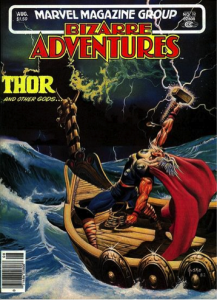
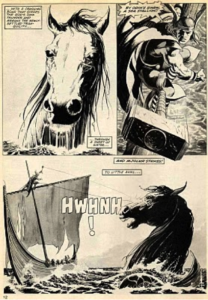
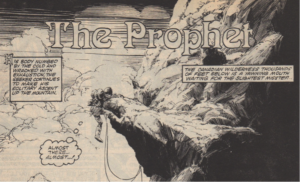
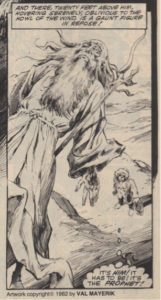
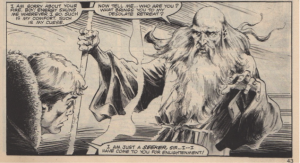
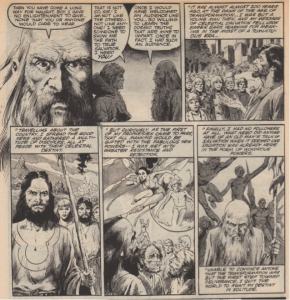

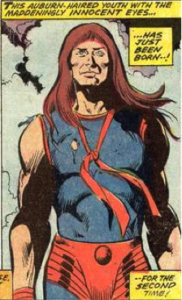
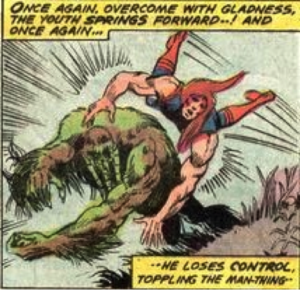
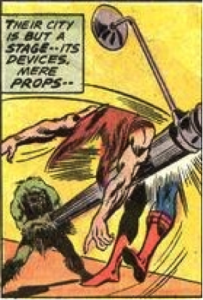
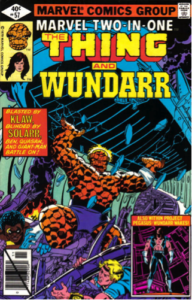
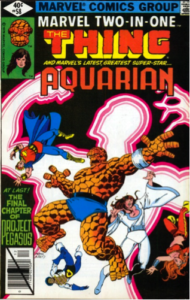
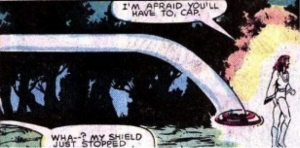
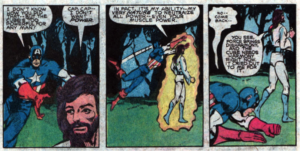

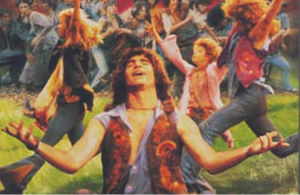
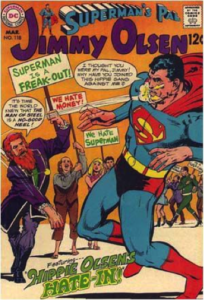
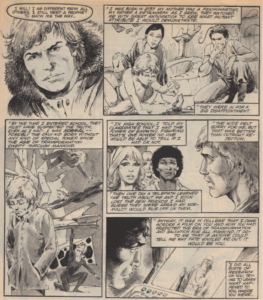
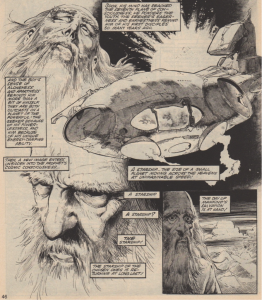
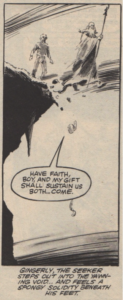
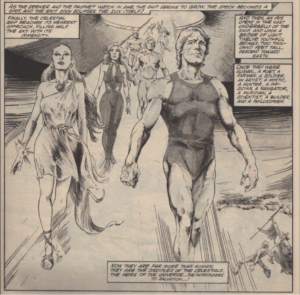
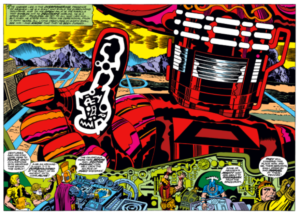
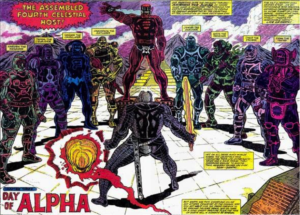
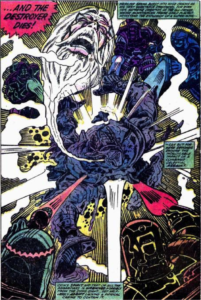
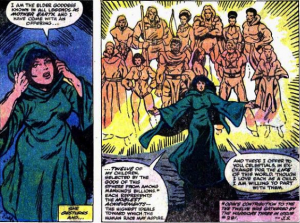
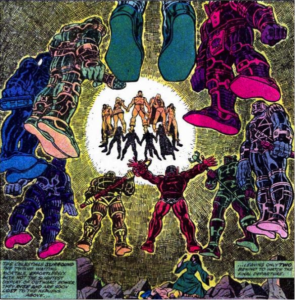
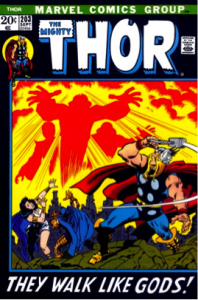
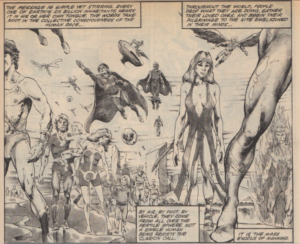
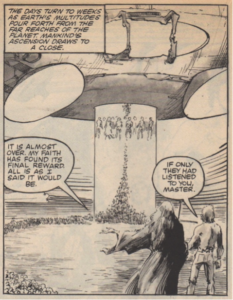
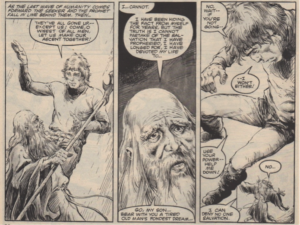
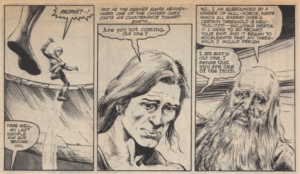
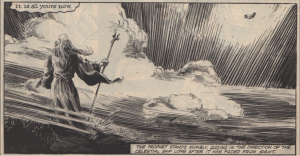
Comments are closed.